

|
Home Updates Hydros Cars Engines Contacts Links ←Pit Box 23 Pit Box 25→ Pit Box Index |
|
Pitbox 24 |
 |
 |
 |
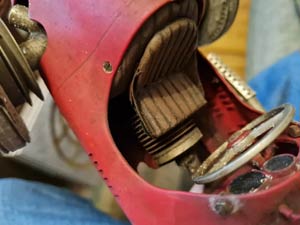 |
 |
|
Henri Baigent Maserati Although better known for his exquisitely modelled scale cars, Henri's core business was originally model engines, firstly the BMP and after that partnership was dissolved, the ERE (English racing Engine) a 2.5cc diesel intended primarily for use in tethered cars. In 1949, he started to produce a series of GP replica cars along with the ERE twinshaft. A basic kit was marketed by Walshaw with BRM or Ferrari bodyshells but Henri went one stage further with the near scale versions of the 4CLT Maserati and an E type ERA with wire wheels, exhaust and cockpit details that put the price up to £16 but with a claimed speed in excess of 70mph. The following year Baigent had expanded his range of car items to include a 1.5cc version of the ERE, a complete railcar, wheels, clutches and more.
More than 100 of the Maserati models were
created as that was the most popular version, each one taking
around ten days to produce, but this is only
the second one known to have come on to the market recently. It
immediately generated a serious amount of interest amongst those
who realised exactly what it was, attracting some serious bids
along the way. Previously one sold at
Christies that cost the buyer £9,500 with commission, so the new
owner of the
above
example got something of a bargain. |
||
 |
 |
 |
 |
 |
|
Manfred Pfeffele's
'Sandrunner'
As well as designing and building an amazing number of cars
and engines for his own use, many of them displaying most
unusual design features, the late Manfred Pfeffele also built
short runs of cars for sale, including this twinshaft powered 'Sandrunner'. It does
bear an obvious similarity to an Oliver 'Bottom's Up', with
the exception of the raised back end that is. The twinshaft
motor will not be familiar to most having just three
cylinder screws and both crank housings removable. This was
a limited run of ten produced by the Moki factory in
Hungary. This model came directly from the Pfeffele estate
so has a direct connection with the builder. The
patterns and a set of castings shown above still exist with another
enthusiast. |
 |
 |
 |
| Jack Morgan's 'Vixen' Jack was a member of the Pioneer Club who was competing at the very first tethered car meeting on the factory roof top in 1943. Later, he built two almost identical cars, the 10cc Red Fox and the 5cc Vixen. The cars, along with Lucy Gascoigne's MG stayed with Jack, despite numerous attempts over the years by Miquel de Rancougne to buy them. As President of the Retro Racing Club, Jack always said that the cars would stay in the family, so it was something of a surprise when the MG and Vixen turned up on ebay in the US. It transpired that the family member who inherited them passed them on to another relative who put them on display in a second hand dress shop in South London, where they were seen and bought by a visitor from the US on a wander. Considering their provenance, the price they realised on ebay was extremely modest. The MG went on a tour of the US, appreciating at every stage, but with us being aware of each new owner. Vixen however vanished completely, until now. Amazingly, it has made its way back to the UK and ended up a very short distance from where Red Fox had been discovered with another Morgan family member. We featured Red Fox back in 2014, but here is the sister car, ten years later. The photos on the left show the car as it is now and on the right in 1946 on the steps of the Royal Horticultural Halls where the Pioneer Club raced. Happily, the car is exactly as it was, one of the true 'pioneering' British tethered cars. Thanks to Peter T for this item and modern photos. October 2024 |
||
 |
 |
 |
 |
| Wizard in car mode with clutch | Gerald Smith's own Wizard | The only Aero version made | NIB with flywheel |
 |
 |
| A pair of twin Wizards from Vernon Gray for marine work with magneto ignition | |
 |
 |
 |
| Most of an engine | Pair of Water cooled single Wizards with magnetos by Vernon Gray | |
| Gerald Smith's Wizard
Engine type 10 and the only one of
Gerald's motors that does not carry the name of a bird. Built around 1948/49,
purely for tethered car racing with fixed ignition and a
needle valve giving full throttle only. Developed from the
earlier Lapwing that was converted for car racing with
horizontal mounting. Around 30 Wizards were made but the
market had effectively vanished leaving Gerald with surplus
castings. These were passed on to Vernon Gray a model shop
proprietor from Leamington who built up a series of marine
engines with magnetos, clutches and recoil starters. Surplus
casting were also passed to a school in Nuneaton to be
completed as engineering projects. Gerald Smith numbered his
engines consecutively so Wizards are around 350 and upward.
The Wizard was the last engine Gerald built for thirty years. |
||
 |
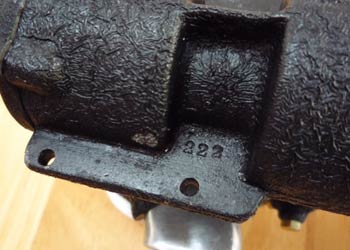 |
| Black
Panther This gem was one of the
many, rare, engines in the collection of the late Ian Russell. The
combined 10cc motor, drive line, gearbox and axle was a product
of the J L Engineering Service company in Los Angeles. Two
separate elements, the motor unit with its integral flywheel, 'cush
drive' and contact breaker assembly all within the crankcase
casting and then with their own drive
unit attached. The engine started life using a Super Cyclone
cylinder married to a purpose built and exceedingly long crankshaft.
Later versions were cast in magnesium with the twin exhaust
cylinders and then crackle finished in black. The engine was described (by J L) variously as 'Screaming streak
of fury', 'Vicious and diabolical', 'Deadly to all competitors'
and 'Absolutely the hottest piece of iron to hit the track' and
all this for just $35. The example shown here has an original
engine unit but with a reproduction torque tube, gearbox and
wheels. The concept kept appearing in various guises right
through to a modern, tethered car version by Peter Rischer.
Alan Knight built a modern
replica, which he described for OTW a while ago.
|
|
 |
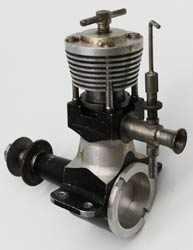 |
 |
 |
| Raylite Panther
The Panther as the result of a commercial
tie up between J A Oliver and Raylite
Supplies of Arkwright Street, also in Nottingham. The owner of
Raylite, Frank Trapp, agreed to market the Oliver Jaguar as the
Panther, but to distinguish between the two the relieved centre
section of the Panther crankcase had the anodising polished off.
It has been suggested that the Panther had some alterations to
make it more powerful 'for speed use' but there is no real
evidence of this as yet. Equally, there seems little, apart from
an engine number to prevent the less scrupulous from polishing
the centre section to create a Panther? A Jaguar is included far
right for comparison. |
|||
 |
 |
 |
| Lothar Runkehl 'Loru'
Lothar Runkehl had an incredibly long
racing career of over sixty years, remaining in the top flight
throughout. Yet more importantly, his successes were achieved
with cars and engines he had built. In 1.5cc and 2.5cc he
managed to interrupt the stranglehold that the eastern Europeans
had for so many years. Not only that he supplied engines and
cars to others in order to compete. Here are two of his
hand crafted 1.5cc motors, one with a tuned pipe that is a work of
art alone and a 2.5cc car, early history as yet unknown. |
||
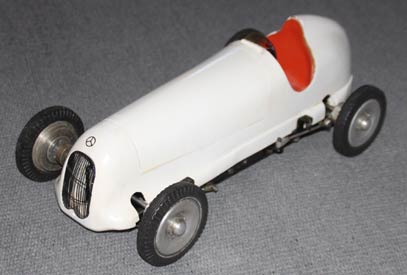 |
 |
| The 'Modella' M&E
M&E Models of
Exmouth marketed their kits and cars through numerous dealers
across the UK. Modella in Bradford manufactured the 5cc, fixed
compression Owat, which was a standard fitting in the front
engined M&Es. It is understood that the car featured here is the
'works' Modella car with one of their own motors fitted. Several
motors of the period required 'pyramid' engine mounts as the
mounting lugs or flanges were way above the crank centre, none
more so than the Owat where the mounting face is on the top of
the crankcase flange. When the car was found it was in
something of a state with more missing than was there. It has
since been the subject of a
two-stage rebuild, the first by Keith
Bragg who built the wooden Mercedes body. The second restoration
remanufactured the rear steering and suspension, completing the
installation of a correct M&E gearbox. |
|
 |
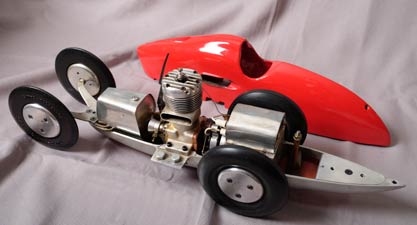 |
| Swedish pedigree
When the Johansson brothers ceased
production of the Swedish Komet engines, the manufacture of these was passed to a small company in Vasteras run
by Roland Wahlstrom and Sven-Erik Ohlsson. It appears that the
new concern only continued production of the 5cc and 10cc
motors, specifically for tethered cars, as this was their prime
interest. However, in addition to the engines, they sold pans,
bodies and other car parts. Both their 5cc and 10cc cars were
based on very short pans with front wheels on long extensions
and a steeply, forward raked front to the body to accommodate
the tank, also seen on
some other European cars of the period. This car now has a McCoy 60 motor and
humungous bridle bolts, probably as a result of a very recent
and rapid rebuild to render it saleable? |
|
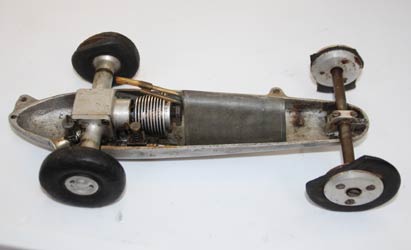 |
 |
| Series 1 Oliver 'Tiger
Two-Five' This
must be the earliest and most original of the 'Tiger
Two-Five' cars yet discovered. It appeared on ebay where the
beady eyes of OTW noticed the venturi sticking out of the
right hand
side of the car. It was snapped up as a BIN and when the new
owner opened it up the reason for the venturi became
obvious, the motor was one of the very first Oliver RVs
#208, possibly either the second or third ever made. Still not
resolved whether the RVB and RV versions started with the
same number? The car is the
first series of castings with the twin brackets for a wire
bridle, which, along with the motor, would have it being
produced early in 1950. The passing seventy years has not
done anything for the tyres, but apart from that, an amazing
discovery. |
|
 |
 |
| ZN Discoveries It was common practice in the late 40s for commercial tethered cars to have axles, wheels and nuts that were handed, ie. left hand threads on one side, right hand on the other. This was so that wheels were self tightening when under power and many a wheel has been ruined when brute force has been used to remove it, rather than turn it the opposite way. Paul Zere's patented semi pneumatic wheels extended this concept to the locking rings that held the two halves of the wheel together. Most will be aware of this information stamped into these rings. Last September though, amongst a large box of ZN related material discovered in a model shop, many years ago were the original ZN press tools that were used to stamp them. One imagines that a flypress was utilised in making these and note the holes for register pins so that the embossing is equally spaced either side of the indentations for the wheel key. Thanks to Jim Hampton for this item. February 2024 |
|
 |
 |
| EMCO The origin of these two engines remained a mystery for many years, as the owner scoured books, magazines and touted them round swapmeets, hoping that someone could put a name to them. That was until one of those coincidences that continue to baffle and amaze us. Having shown it to a stall holder at a swapmeet with no success, a fellow member of the public leaned over and said 'I know what that is', 'it's an EMCO, and not only that I have the drawings for that and a smaller engine from the same company'. This single piece of information made sense of the name, as it is the acronym for the Model and Experimental Company, better known to us as E&M of Coventry. Some of their adverts mention model engines, but no photos have ever been found, either of this engine or the smaller 2.2cc model. What makes the 6cc version so unusual is the mounting holes that go transversely through the crankcase, possibly unique in model engine design. The smaller motor had one single bolt into the rear of the crankcase. So far, no one we have spoken to or any of the resources we have can shed any light on this obscure and rare British engine, especially as it emanated from a relatively well established company?
Information on this and the smaller motor
is almost non existent, so if anyone can provide anything
further such as an ad then we would be most grateful. |
|
©copyrightOTW2024